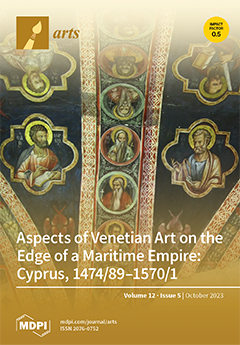In this article, author and artist Meena Murugesan analyzes their creative process and research in the making of
Dravidian Futurities, a multi-channel video installation with live performance. Methodologies of auto-ethnography, visual aesthetics, embodied movement practices, Tamil historiographies, queer futurities, caste analysis, and
[...] Read more.
In this article, author and artist Meena Murugesan analyzes their creative process and research in the making of
Dravidian Futurities, a multi-channel video installation with live performance. Methodologies of auto-ethnography, visual aesthetics, embodied movement practices, Tamil historiographies, queer futurities, caste analysis, and poetics are applied to treat the issues at hand.
Dravidian Futurities draws connections between communities of South Indian and Sri Lankan Shudra and Dalit caste backgrounds, Dravidian, and Afro-Indian peoples, depending on the historical era examined. As someone of the Shudra caste, the author draws connections between agriculture, land, and earth, as being rooted in Shudra identities, and in opposition to brahminical systems. Therefore, the movement forms of somatics, improvisation, and nature-based embodiment practices are investigated as possible embodied inroads to grapple with caste within brahminized bharatanatyam. Notions of futurity and place-making are unearthed from the depths of the Indian Ocean with a hypothetical sunken landmass called Lemuria or Kumari Kandam that might have once connected South India, Sri Lanka, and Madagascar.
Dravidian Futurities also dreams into existence this speculative landmass as a possible utopia we might co-build, similar to that which Dalit mystic saint Guru Ravidas imagined five hundred years ago with Begumpura (“land without sorrow”) as a casteless, stateless utopia.
Full article




